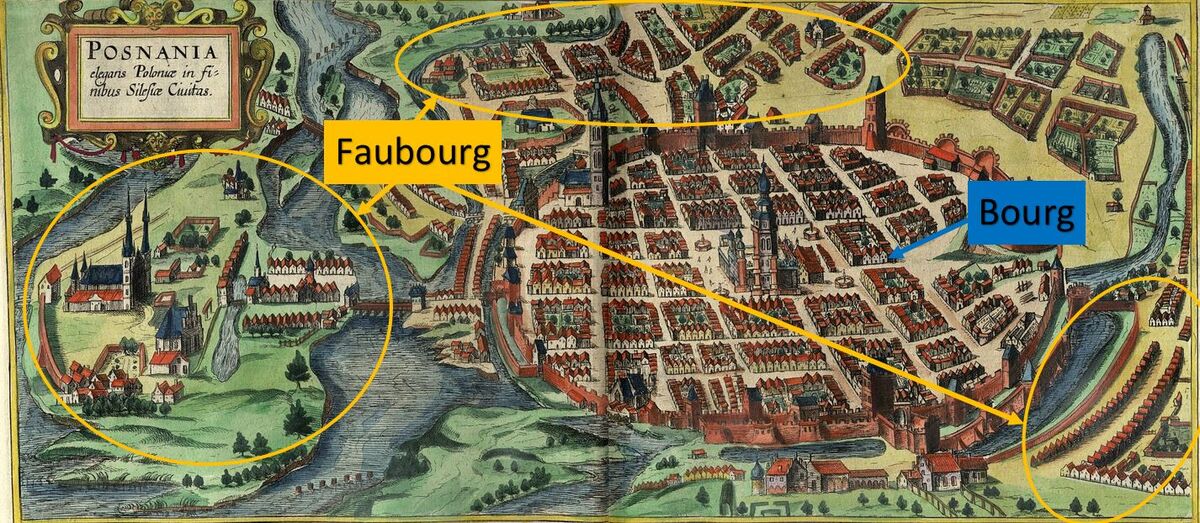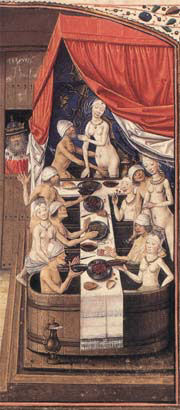The concepts covered in this fact sheet go beyond those seen in high school. It is intended as a supplement for those who are curious to learn more.
A faubourg was a district located outside the walls or beyond the gates of a city.
The new districts, known as faubourgs, were located close to where commercial activities were concentrated, i.e. near markets and fairs, but also near towns and fortifications. Merchants thus benefited from the protection of the walls. Later, these new districts were brought together within the new, larger city walls. The inhabitants of the suburbs, the bourgeois, benefited from the institutions of the commune.

Map of the medieval city of Poznan in Poland
Note : An image in English is coming soon.
Towns were mainly located near trade routes: seas, rivers, main roads, etc. Some were located near the richest agricultural areas. Some were located near the richest agricultural territories, where it was easier to sell produce and gain access to agricultural products. In both cases, the choice of town location was directly motivated by commercial activities and the efficiency of trade.
In addition to these two factors, some towns born in Gallo-Roman times simply continued to evolve, since the infrastructure, population and fortifications were already in place. Finally, many towns were founded around important sites such as cathedrals, monasteries or fortified squares.
Gradually, towns grew in size, with many new buildings and an ever-increasing number of inhabitants. As they took on the economic role of producing goods and trading, they quickly developed activities linked to the secondary (processing raw materials) and tertiary (sales, commerce, finance) sectors.
Craftsmen had left the seigneurial estates to work in the towns. This movement of craftsmen and merchants to the cities gave rise to a new social class: the bourgeoisie. Although the bourgeoisie represented only 10% of the city's total population, it was they who ensured its economic, political and social vitality. Cities were no longer just the seat of power, they were also the symbol of a new wealth and the heart of artistic life.
The creation of universities and colleges also contributed to the transformation of the urban face. In the 13th century , merchants, craftsmen, counts, bishops, students and beggars all lived in the heart of the new cities.
Depending on their size, role and importance, towns were divided into three main categories: small towns, provincial capitals and metropolises. Small towns were where weekly markets were held. Located closer to agricultural activities, they were home to only a few craftsmen. Provincial capitals were home to numerous merchants and craftsmen, as well as the agents of kings and princes. Metropolises were major urban centers with very large populations. They also represented the military strength of the state where the king lived, and a major commercial center for the Grand Commerce. In short, a metropolis had to be a political, military and economic force with influence over a vast region.
Construction work and building sites often occupied entire city lots. Whether for the construction or maintenance of buildings, cities often included a huge construction site needed to build castles, fortifications, gates, cathedrals, palaces and so on.
Towns and suburbs were home to craftsmen and merchants. Small houses and workshops filled the streets and squares of the protected town. From the 13th century onwards, stone constructions replaced wooden or wattle-and-daub buildings, which were too fragile and unstable in the event of fire.
A market town is a rural agglomeration of lesser importance than the city, where the market of the surrounding villages is usually held. The term “bourg” is generally used to designate a town of intermediate size between a village and a city.
At the same time, a number of urban planning projects were underway to control urban development. These first urban planning regulations aimed to space out the built-up areas, pave the streets, manage water distribution and dispose of garbage. These early urban planning regulations also aimed to enhance monuments, whether religious (churches, cathedrals, episcopal palaces, convents) or secular (belfries, town halls, public squares).
Wealthy merchants, counts and their families enjoyed large, multi-storey homes. These houses included several specialized rooms: kitchen, wardrobe, study room, reception rooms, private chapel, as well as stables and towers. Gardens adorned the exterior.
The family's wealth was also reflected in the home's comfort features, such as fireplaces, chimneys and windows. Hygienic conditions were also superior in these homes, thanks to the filtering well, sewage disposal system and latrines. These homes were also richly decorated. This decoration was inspired by Italian houses: multicolored paving, frescoes painted on the walls, paintings adorning the ceilings and furniture. Most of these decorations reproduced the family coat of arms.
Much smaller than the homes of merchants, those of the working classes bordered on insalubrity: cramped, poorly ventilated rooms lit by low-quality oil lamps and candles made from animal fat.
Craftsmen usually divided their homes into two separate rooms on the first floor. The room facing the street served as workshop and store, while the room at the back was reserved for family life. The upper rooms were generally occupied by the bedrooms and workshops of professional craftsmen such as goldsmiths (jewelry makers).
In the homes of wealthier people, baths were taken in large wooden basins, which were also used for washing clothes. For the poorest, public baths were available. By 1292, the city of Paris already boasted 26 public baths. Free of charge, these baths ensured better hygiene for all the city's inhabitants.

An example of a public bath
In addition, exposed areas (face, neck, hands, arms) should be washed frequently before meals or at other times.
City life was often punctuated by festivals and fairs, during which townspeople could watch strolling musicians, jugglers and animal trainers. They could also consult fortune-tellers, take part in games of skill and more. On major religious or royal occasions, people were invited to share a banquet, watch a procession and dance.